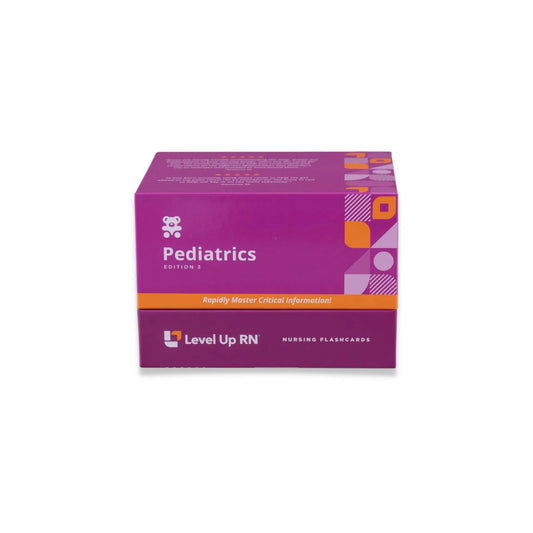Peds, part 17: Respiratory Disorders - Pertussis, Influenza, Pneumonia
Updated: Cathy ParkesPertussis (whooping cough), influenza, and pneumonia. The pathophysiology, prevention, signs/symptoms, diagnosis, and treatment of these disorders.
Full Transcript: Peds, part 17: Respiratory Disorders - Pertussis, Influenza, Pneumonia
Full Transcript: Peds, part 17: Respiratory Disorders - Pertussis, Influenza, Pneumonia
Hi, I'm Cathy with Level Up RN. In this video, I'm going to continue my coverage of respiratory system disorders in the pediatric population. In this video, I will be talking about pertussis, influenza, and pneumonia. At the end of the video, I'm going to give you guys a little quiz to test your knowledge of some of the key points I'll be covering in this video. So definitely stay tuned for that. And if you have our Level Up RN Pediatric Nursing Flashcards, definitely pull those out so you can follow along with me.
First up, we have pertussis, which is known as whooping cough. This is a highly contagious bacterial infection of the respiratory tract that is spread through droplets, and it is largely preventable with the DTaP vaccine, which is recommended for all children. With DTaP, the P stands for pertussis. So risk factors associated with this disorder include close contact with an infected person, lack of vaccination, and immunodeficiency. Signs and symptoms include a low grade fever, rapid coughing, followed by high-pitched inhalation with a characteristic "Whoop" sound. So that is the hallmark symptom of this disorder. Pertussis can also cause vomiting and cyanosis, and if coughing is violent enough, it has been known to crack ribs, so it's a very serious condition. The coughing is very extreme. In terms of diagnosis. We can do a nasopharyngeal swab to check for the presence of the pertussis bacteria. And then treatment includes antibiotics, oxygen therapy, and suctioning. In terms of nursing care, we're going to want to place our patient on droplet precautions and then position our patient in a high Fowler's position during periods of coughing.
Next, we have influenza, which is a very common viral infection of the respiratory tract. It is spread through droplets. So we have the influenza vaccine, which can help prevent the flu. It's recommended that children get this vaccine annually, starting at age six months. Signs and symptoms of influenza include fever, chills, cough, sore throat, muscle aches, headache, and fatigue. We can diagnose influenza through a nasopharyngeal swab, and then treatment can include the use of antiviral agents, such as oseltamivir. However, it's important to remember that we must initiate this antiviral medication therapy within 48 hours of the onset of flu symptoms. In addition, we want to encourage increased fluid intake and the use of acetaminophen or ibuprofen for fever. It's important that the parent know that no aspirin should be used with the child due to the risk of Reye's syndrome.
Next, we have pneumonia, which is an infection of the lungs. It can be caused by a viral infection, which is most common, a bacterial infection, or a fungal infection. So no matter the causative agent, it results in the alveoli filling up with fluid and/or pus. So the PCV vaccine, which is the pneumococcal vaccine that is recommended for all children, this vaccine is effective against 13 different types of pneumococcal bacteria which can cause pneumonia. So this vaccine definitely helps to prevent pneumonia. In terms of signs and symptoms of pneumonia, those include chest pain, fever, cough, abnormal lung sounds, so crackles or decreased breath sounds on the affected side. The child may also have signs of respiratory distress, such as nasal flaring or retractions. And then when oxygenation is decreased significantly, the child may end up with pallor or cyanosis. So in terms of diagnosis, we would do a chest x-ray to help diagnose pneumonia. Labs will show an elevation in white blood cells, and we will also likely see a decrease in oxygen saturation. In terms of treatment, we would use antibiotics, antivirals, or antifungal agents, depending on the causative agent. We would also provide oxygen, IV fluids, and antipyretics as needed.
All right, it's time for a quiz. I have four questions for you. First question, what respiratory disorder causes rapid coughing followed by a high pitched whooping sound? The answer is pertussis. Question number two, what precautions are required for a patient with pertussis? The answer is droplet precautions. Question number three, when should anti-viral agents be initiated for influenza? The answer is within 48 hours of the onset of symptoms. Question number four, vaccinations can help prevent all of the disorders that we talked about in this video. True or false? The answer is true. Okay, that's it for this video. If you found it helpful, definitely like this video. Leave me a comment. Take care, and good luck with studying.



1 comment
Thank you:) clear explanation